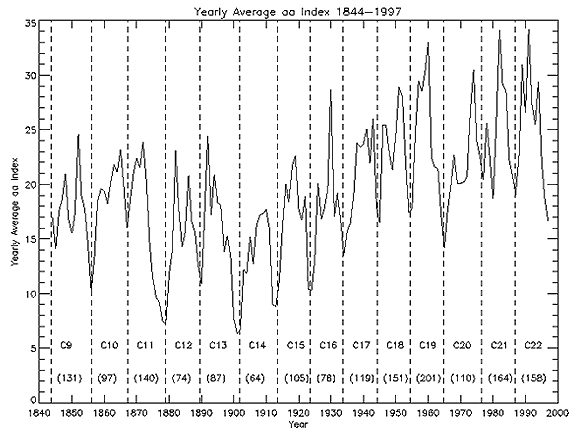Variation of Geomagnetic Activity Since 1844
It is well known that the number of geomagnetic disturbances varies during the solar cycle. Near solar minimum, disturbances are quite rare. But as the cycle rises to a peak of sunspot number, disturbances become more numerous.
This picture of geomagnetic activity is basically correct; but the more detailed picture is much more complicated. During most solar cycles, geomagnetic activity varies considerably, rising to peaks and then falling to troughs.
Geomagnetic activity is measured by a number of indices, some of which have been available for many years. The longest running series of any index is that of the aa index. This index is based on observations at two nearly antipodal stations (Canberra in Australia and Hartland in the United Kingdom). This means that the index is a global index, representing world-wide magnetic activity rather than local features.
The graph shows the variation of the yearly-average aa index since 1844. The vertical lines show the time of solar minimum for each of the solar cycles since the start of Cycle Number 9. The numbers at the base of the graph is the Cycle Number and those in brackets is the amplitude (of the smoothed sunspot number) for each cycle.
Cycles show very different variations in activity. All exhibit multiple peaks of activity - mostly with three peaks although some with only two. Some cycles have the peak activity concentrated early in the solar cycle (e.g. Cycles 11, 13, and 19). Other cycles have activity concentrated late in the Cycle (e.g. Cycles 10, 14, and 17), whilst others are more evenly distributed.
Activity during Cycle 21 was particularly strange because of the deep trough in the middle of the cycle where the average aa index in fact dropped below its value at the previous minimum. Cycles 9, 12 and 18 also have deep troughs but not as pronounced as that for Cycle 21.

Material prepared by Richard Thompson.





